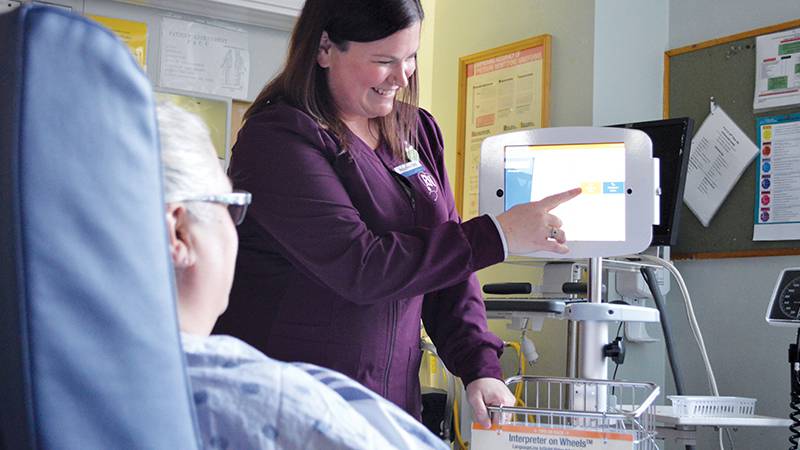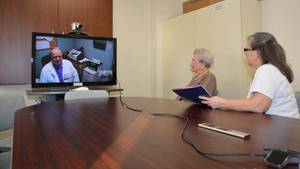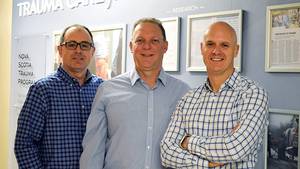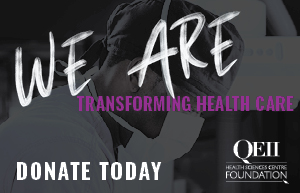Imagine you’ve just woken up from surgery. You’re sleepy, confused and probably a little worried about how everything went. A nurse approaches to check on you and your first instinct is to ask for reassurance: “Was my surgery a success? Where is my family? How long do I have to stay here?”
Now, imagine the nurse doesn’t understand what you’re saying and can’t offer any information in your own language. Maybe you don’t have to imagine — maybe it’s happened to you or someone close to you.
In perioperative care — the journey from pre-admission assessment to surgery to recovery and discharge — at the QEII Health Sciences Centre, those days are over. In the fall of 2019, perioperative care teams at the QEII received Interpreter on Wheels equipment and technology, thanks to funding from the QEII Foundation Comfort & Care grant program.
Comfort & Care grants were established in 2005 by the QEII Foundation to directly enhance care for patients and their families. These grants support projects that typically would not receive funding from operating or capital budgets.
“In the Post Anesthetic Care Unit (PACU) our patients are in crisis and it can be hard to communicate with a patient whose first language isn’t English,” explains health services manager Patricia Jennex. “With the
Interpreter on Wheels, physicians and nurses can ask questions about things like pain and post-surgery concerns.”
“It can follow patients into pre-admission assessment, into the ORs if needed, into recovery and then help with discharge teaching,” adds perioperative nurse Heather Aikens.
But what exactly is an Interpreter on Wheels and how is it different from an in-person interpreter?
“It’s an iPad locked into a stand with wheels,” says Patricia. “You turn it on and select the language you want on a touchscreen. Interpreters are on call all over the world, 24 hours a day. They receive specific training in a
variety of scenarios, including health care.”
If it sounds simple, it is — and quite amazing. Four hundred languages are available through a service called LanguageLine, most with both live video and audio interpretation. Declining video streaming is always an
option if the patient wants more privacy. “But most people find it reassuring to have a face to talk to,” says Patricia.
Before Interpreter on Wheels, interpreters had to be booked in advance through the Nova Scotia Health Authority’s Interpretation and Language Services.
“This works well, but has limitations,” says Patricia, “such as emergencies, surgical delays and a limited menu of languages. If we needed immediate interpreting, we would sometimes ask staff members. They’re more than happy to do it, but it means removing a staff member from their other patients or duties. This can impact the flow of patients in and out of the PACU and care of patients in the unit.”
It’s reassuring to know we can provide the safest, most holistic care we can for our patients.
— Heather Aikens
Interpretation and Language Services supports the Interpreter on Wheels program by providing software, staff training and support.
Interpretation is now available at any point in the patient’s perioperative care journey.
“The consent leading up to surgery is so important,” says Heather. “Things with your health status can change between pre-admission and the actual surgery and patients need to understand all the things they can and can’t do before surgery.”
Patricia points to a more diverse population as a key reason for improving interpretation services at the QEII. Even if the patient or family speaks English as an additional language, they might not be familiar with medical vocabulary and they might feel stressed. “In addition to welcoming immigrants and refugees, there are university students from all over the world and cruise ship patients on a regular basis.”
The Nova Scotia population is also aging, which can pose challenges in the recovery room. “Maybe the patient doesn’t have their glasses or dentures or hearing aids,” adds Patty. “The Interpreter on Wheels provides a sense of comfort and security.”
The benefits extend to nurses and other healthcare providers as well.
“It’s a comfort because if I’m sending patients home and I am unsure if they understand what they need to do for post-operative care, that’s not a good feeling,” says Heather. “It’s reassuring to know we can provide the safest, most holistic care we can for our patients. Patients are thanking the interpreter and you can see the relief and feel the anxiety coming down when they know they can communicate and get the help they need.”








